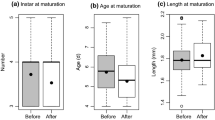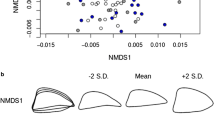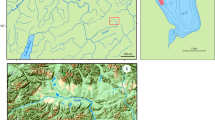Abstract
During the first few weeks of a recurring seasonalperiod of diel vertical migration in Lake Maarsseveen(The Netherlands), part of the hybrid Daphniagaleata × hyalina population migrated, whileanother part remained in the epilimnion. In theepilimnion, 0+ perch prey upon daphnids duringdaytime. Gradually, the number of adult Daphniain the epilimnion decrease until the epilimnion isnearly devoid of daphnids. The population as a wholemay decrease, as in 1991, or may increase asin 1992. Genotype composition, as determined byallozyme analysis, changed substantially within afortnight in 1992, and one genotype became dominant.Our data are in agreement with the hypothesis thatpredation on different genotypes (clones)occurs during the beginning of a seasonal period ofdiel vertical migration, though our data do not allowto exclude alternativeexplanations.
Similar content being viewed by others
References
De Meester, L., 1990. Evidence for intra-population genetic variability for phototactic behaviour in Daphnia magnaStraus, 1820. Biol. Jb Dodonaea 58: 84–93.
De Meester, L., 1993. Genotype, fish-mediated chemicals, and phototactic behavior in Daphnia magna. Ecology 74: 1467–1474.
De Meester, L., 1996. Evolutionary potential and local genetic differentiation in a phenotypically plastic trait of a cyclical parthenogen, Daphnia magna. Evolution 50: 1293–1298.
De Meester, L. & H. J. Dumont, 1988. The genetics of phototaxis in Daphnia magna: Existence of three phenotypes for vertical migration among parthenogenetic females. Hydrobiologia 162: 47–55.
De Meester, L., L. J. Weider & R. Tollrian, 1995. Alternative anti-predator defences and genetic polymorphism in a pelagic predator-prey system. Nature 378: 483–485.
Flik, B. J. G., D. Aanen & J. Ringelberg, 1997. The extent of predation by juvenile perch during diel vertical migration of Daphnia. Arch. Hydrobiol. Beih. Ergebn. Limnol. 49: 51–58.
Flik, B. J. G. & J. Ringelberg, 1993. Influence of food availability on the initiation of diel vertical migration (DVM) in Lake Maarsseveen. Arch. Hydrobiol. Beih. Ergebn. Limnol. 39: 57–65.
Forward, R. B., 1993. Photoresponses during diel vertical migration of brine shrimp larvae: effect of predator exposure. Arch. Hydrobiol. Beih. Ergebn. Limnol. 39: 37–44.
Gliwicz, M. Z., 1986. Predation and the evolution of vertical migration in zooplankton. Nature 320: 746–748.
Hebert, P. D. N., 1987. Genotypic characteristics of cyclic parthenogens and their obligately asexual derivates. In S. Stearns (ed.), The evolution of sex and its consequences, Birkhäuser Verlag, Basel: 175–195.
Hebert, P. D. N. & M. J. Beaton, 1989. Methodologies for allozyme analysis using cellulose acetate electrophoresis. Helena Laboratories Beaumont, Texas, 32 pp.
Huntingford, F. A. & N. B. Metcalfe, 1986. The evolution of anti-predatory behaviour in zooplankton. Nature 320: 682.
King, C. E. & M. R. Miracle, 1995. Diel vertical migration by Daphnia longispinain a Spanish lake: Genetic sources of distributional variation. Limnol. Oceanogr. 40: 226–231.
Loose, C. J., 1993. Daphniadiel vertical migration behavior: Response to vertebrate predator abundance. Arch. Hydrobiol. Beih. Ergebn. Limnol. 39: 29–36.
Loose, C. J., E. Von Elert & P. Dawidowicz, 1993. Chemically-induced diel vertical migration in Daphnia–a new bioassay for kairomones exuded by fish. Arch. Hydrobiol. 126: 329–337.
Lynch, M., 1987. The consequences of fluctuating selection for isozyme polymorphisms in Daphnia. Genetics 115: 657–669.
Lynch, M. & W. Gabriel, 1983. Phenotypic evolution and parthenogenesis. Am. Nat. 122: 745–764.
Müller, J. & A. Seitz, 1993. Habitat partitioning and differential vertical migration of some Daphniagenotypes in a lake. Arch. Hydrobiol. Beih. Ergebn. Limnol. 39: 167–174.
Neill, W. E., 1992. Population variation in the ontogeny of predator-induced vertical migration of copepods. Nature 356: 54–57.
Ohman, M. D., 1990. The demographic benefits of diel vertical migration by zooplankton. Ecol. Monogr. 60: 257–281.
Reede, T., 1995. Life history shifts in response to different levels of fish kairomones in Daphnia. J. Plankton Res. 17: 1661–1667.
Reede, T. & J. Ringelberg, 1995. The influence of a fish exudate on two clones of the hybrid Daphnia galeata × hyalina;. Hydrobiologia 307: 207–212.
Ringelberg, J., 1991a. Enhancement of the phototactic reaction in Daphnia-hyalinaby a chemical mediated by juvenile perch (Perca-fluviatilis). J. Plankton Res. 13: 17–25.
Ringelberg, J., 1991b. A mechanism of predator-mediated induction of diel vertical migration in Daphnia hyalina. J. Plankton Res. 13: 83–89.
Ringelberg, J., B. G. J. Flik, D. Lindenaar & K. Royackers, 1991. Diel vertical migration of Daphnia hyalina(sensu latiori) in Lake Maarsseveen: Part: 1. Aspects of seasonal and daily timing. Arch. Hydrobiol. 121: 129–145.
Ringelberg, J. & B. J. G. Flik, 1994. Increased phototaxis in the field leads to enhanced diel vertical migration. Limnol. Oceanogr. 39: 1855–1864.
Ringelberg, J., B. J. G. Flik, D. Aanen & E. Van Gool, 1997. Amplitude of diel vertical migration (DVM) is a function of fish biomass, a hypothesis. Arch. Hydrobiol. Beih. Ergebn. Limnol. 49: 71–78.
Sokal, R. R. & F. J. Rohlf, 1995. Biometry. W.H. Freeman & Co, San Francisco USA, 887 pp.
Spaak, P., 1996. Temporal changes in the genetic structure of the Daphniaspecies complex in Tjeukemeer, with evidence for back-crossing. Heredity 76: 539–548.
Spaak, P. & J. R. Hoekstra, 1993. Clonal structure of the Daphnia population in LakeMaarsseveen: its implications for diel vertical migration. Arch. Hydrobiol. Beih. Ergebn. Limnol. 39: 157–165.
Stich, H. B. & W. Lampert, 1981. Predator evasion as an explanation of diurnal vertical migration by zooplankton. Nature 293: 396–398.
Swain, W., R. Lingeman & F. Heinis, 1987. A characterization and description of the Maarsseveen lake system. Hydrobiol. Bull. 21: 5–16.
Weider, L. J., 1984. Spatial heterogeneity of Daphniagenotypes: Vertical migration and habitat partitioning. Limnol. Oceanogr. 29: 225–235.
Wolf, H. G. & M. A. Mort, 1986. Interspecific hybridization underlies phenotypic variability in Daphniapopulations. Oecologia 68: 507–511.
Zaret, T. M. & J. S. Suffern, 1976. Vertical migration in zooplankton as a predator avoidance mechanism. Limnol. Oceanogr. 21: 804–813.
Author information
Authors and Affiliations
Rights and permissions
About this article
Cite this article
Spaak, P., Ringelberg, J. Differential behaviour and shifts in genotype composition during the beginning of a seasonal period of diel vertical migration. Hydrobiologia 360, 177–185 (1997). https://doi.org/10.1023/A:1003121520393
Issue Date:
DOI: https://doi.org/10.1023/A:1003121520393




